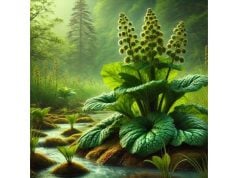
Bearberry is a fascinating herb with a rich heritage and a wide range of applications. Known for its vibrant red berries and evergreen leaves, bearberry has been used for centuries in traditional medicine, particularly by Native American communities and early European settlers. This hardy shrub, belonging to the Arctostaphylos uva-ursi species, is celebrated not only for its distinctive flavor and aroma but also for its powerful bioactive compounds that offer impressive health benefits. From supporting urinary tract health to providing antioxidant protection and aiding in skin care, bearberry is a versatile herb that bridges ancient wisdom and modern science.
In this article, we’ll dive deep into the world of bearberry. We’ll start by looking at its botanical profile and how to identify this remarkable plant in nature. Then, we’ll explore its fascinating history and cultural significance, followed by a detailed analysis of its phytochemical profile and key active components. Next, we’ll discuss the numerous health benefits bearberry offers, from digestive support to immune enhancement and skin healing. We’ll also cover its natural properties, practical uses, and important safety guidelines. Finally, we’ll review some significant scientific studies and answer frequently asked questions about bearberry. Whether you’re a long-time herbal enthusiast or just curious about natural remedies, bearberry has something to offer for every aspect of well-being.
- Supports urinary tract health and helps prevent infections
- Provides powerful antioxidant and anti-inflammatory benefits
- Aids in skin healing and helps reduce acne and other skin irritations
- Enhances immune function and protects against free radical damage
- Promotes digestive health and supports detoxification
- Helps soothe and relieve minor urinary discomfort
- Contributes to overall vitality and natural well-being
Table of Contents
- Bearberry Botanical Profile and Identification
- Bearberry Historical Background and Cultural Significance
- Bearberry Phytochemical Profile and Active Components
- Bearberry Health Benefits and Wellness Contributions
- Bearberry Natural Properties and Medicinal Attributes
- Bearberry Uses, Applications, and Safety Guidelines
- Bearberry Scientific Insights and Significant Studies
- Frequently Asked Questions About Bearberry
Bearberry Botanical Profile and Identification
Bearberry, commonly known as kinnikinnick or uva-ursi, is a low-growing evergreen shrub belonging to the Ericaceae family. Native to the cool temperate regions of North America, Europe, and Asia, bearberry thrives in well-drained, sandy or rocky soils. The plant is best recognized by its small, leathery leaves, which remain green year-round, and its bright red berries that appear in the late summer and autumn.
Visual Characteristics
Bearberry plants are modest in stature, usually growing no more than 1 to 2 feet tall, and spreading widely to form a dense mat. Here are some of the key identification features:
- Leaves: The leaves of bearberry are small, oval, and leathery, typically measuring between 1/4 to 1/2 inch long. They are arranged alternately along the stems and have a glossy, dark green appearance. When rubbed, the leaves release a subtle, slightly resinous fragrance.
- Berries: Perhaps the most striking feature of bearberry is its clusters of bright red berries. These berries are small, round, and waxy in texture. As they mature, they develop a shiny, almost translucent appearance due to a natural wax coating that helps protect the seeds.
- Growth Habit: Bearberry grows as a prostrate shrub, forming dense ground cover. Its sprawling habit makes it an excellent choice for erosion control and natural landscaping, especially in areas with poor soil.
- Bark and Twigs: The twigs of bearberry are slender and brown, often covered with fine hairs. The bark is generally smooth, and in winter, the evergreen foliage provides a striking contrast against a snow-covered landscape.
Habitat and Growing Conditions
Bearberry is well-adapted to harsh environments where few other plants can thrive. It is commonly found in coastal, alpine, and boreal regions.
- Soil: It prefers well-drained, sandy, or rocky soils with low nutrient content. Bearberry’s ability to grow in such conditions makes it a hardy and resilient ground cover.
- Climate: Bearberry is a cold-hardy plant, capable of withstanding harsh winters and short growing seasons. It thrives in regions with cool temperatures and plenty of sunlight.
- Watering: Once established, bearberry is drought-tolerant and requires minimal watering, making it an ideal choice for xeriscaping and low-maintenance gardens.
- Propagation: Bearberry is typically propagated through seed or by layering, a process in which branches are encouraged to take root. This method helps maintain its natural spread and density.
- Ecological Role: Beyond its ornamental value, bearberry plays a crucial role in its ecosystem by stabilizing soil, providing habitat for small animals, and serving as a food source for birds.
Understanding the botanical characteristics of bearberry not only aids in its identification but also highlights its resilience and adaptability. Its evergreen nature and ability to thrive in challenging conditions have made it an important plant both ecologically and medicinally.
Bearberry Historical Background and Cultural Significance
Bearberry boasts a rich cultural and historical legacy that spans centuries. Its use dates back to ancient times, particularly among Native American tribes, who recognized its medicinal value and incorporated it into their traditional healing practices. Over time, bearberry also found favor with early European settlers and was integrated into various folk remedies.
Traditional Medicinal Uses
Historically, bearberry was used to treat a variety of ailments. Its leaves, in particular, have been valued for their antiseptic and diuretic properties.
- Urinary Tract Support: Native American tribes traditionally used bearberry tea to support urinary tract health. Its natural diuretic effects help flush out bacteria and prevent infections.
- Respiratory Health: Bearberry was also employed as a remedy for respiratory conditions such as coughs and bronchitis. The herb’s soothing properties helped calm irritated airways.
- Digestive Aid: In folk medicine, bearberry was used to alleviate digestive discomfort, including indigestion and stomach aches, thanks to its mild bitter components.
- General Tonic: Bearberry was considered a general tonic that promoted overall health and vitality. It was believed to strengthen the body and help ward off illnesses.
Cultural and Symbolic Importance
In addition to its medicinal uses, bearberry holds cultural significance in many indigenous traditions.
- Symbol of Resilience: The hardy nature of bearberry, which thrives in tough, often barren environments, has made it a symbol of resilience and endurance.
- Ritual and Ceremony: The plant was often used in purification rituals and healing ceremonies, where its leaves and berries were valued for their protective and restorative properties.
- Culinary Uses: Although primarily known for its medicinal benefits, bearberry was sometimes used as a flavoring agent in traditional dishes, imparting a subtle, earthy taste.
Modern Revival
Today, there is a renewed interest in bearberry as part of the broader movement toward natural and holistic health practices.
- Herbal Medicine: Modern herbalists incorporate bearberry into teas, tinctures, and supplements to support urinary tract and respiratory health.
- Eco-Friendly Landscaping: Bearberry’s ability to act as a ground cover in poor soils has made it popular in sustainable gardening and landscaping projects.
- Natural Skincare: Extracts of bearberry are now being used in natural skincare formulations for their antioxidant and anti-inflammatory properties.
- Cultural Preservation: Efforts are underway to preserve traditional knowledge about bearberry, ensuring that its historical and cultural significance continues to be recognized and celebrated.
The historical journey of bearberry is a testament to its enduring value. Its traditional uses, passed down through generations, provide a solid foundation for its modern applications in natural health and wellness.
Bearberry Phytochemical Profile and Active Components
The health benefits of bearberry are deeply rooted in its diverse phytochemical profile. This remarkable herb contains a variety of bioactive compounds that work together synergistically to support its therapeutic properties. Modern research has identified several key components in bearberry that contribute to its effectiveness in traditional medicine and modern herbal practices.
Key Active Components
- Triterpenoids: Bearberry is particularly rich in triterpenoids, a class of compounds known for their anti-inflammatory and antimicrobial properties. These compounds help to reduce inflammation and support the immune system.
- Flavonoids: The flavonoids present in bearberry, including quercetin and kaempferol, serve as potent antioxidants. They help neutralize free radicals, protecting cells from oxidative damage and supporting overall health.
- Phenolic Acids: Bearberry contains several phenolic acids, such as caffeic acid and ferulic acid, which contribute to its antioxidant activity and help modulate inflammatory responses.
- Saponins: Saponins in bearberry have been associated with diuretic and cholesterol-lowering effects, and they also play a role in its antimicrobial activity.
- Essential Oils: Although bearberry is more renowned for its waxy berries, its essential oils contribute to its overall therapeutic profile by providing mild antimicrobial and anti-inflammatory benefits.
- Polyphenols: A broad spectrum of polyphenolic compounds enhances the antioxidant capacity of bearberry, supporting cardiovascular and metabolic health.
- Vitamins and Minerals: Bearberry is a good source of essential nutrients, including vitamin C and various B vitamins, along with minerals such as magnesium and potassium, which are vital for overall cellular function.
Synergistic Interactions
The true efficacy of bearberry is a result of the synergistic interplay between its numerous bioactive compounds. The combination of triterpenoids, flavonoids, phenolic acids, saponins, and polyphenols creates a powerful natural remedy that supports multiple body systems simultaneously. This synergy not only enhances bearberry’s antioxidant and anti-inflammatory effects but also bolsters its overall therapeutic potential.
Advanced analytical techniques, such as high-performance liquid chromatography (HPLC) and mass spectrometry (MS), have been employed to map the complex chemical composition of bearberry. These studies provide compelling evidence that the rich blend of bioactive compounds in bearberry is directly responsible for its wide-ranging health benefits, confirming its longstanding use in traditional medicine.
Bearberry Health Benefits and Wellness Contributions
Bearberry is celebrated for its impressive array of health benefits, many of which have been cherished in traditional herbal medicine and are now being substantiated by modern research. The herb’s diverse bioactive profile supports numerous aspects of health, making it a valuable addition to natural wellness routines.
Urinary Tract and Kidney Health
One of the most well-known uses of bearberry is in supporting urinary tract health. Its natural diuretic properties have made it a traditional remedy for urinary tract infections (UTIs) and other related conditions.
- Diuretic Effects: Bearberry stimulates urine production, which helps flush out bacteria and toxins from the urinary tract.
- Antimicrobial Action: The antimicrobial compounds in bearberry help prevent the growth of bacteria that can cause infections.
- Soothing Irritation: By reducing inflammation, bearberry helps soothe the lining of the urinary tract, alleviating discomfort.
Immune System Support
Bearberry’s potent antioxidants and antimicrobial compounds make it a natural ally for boosting the immune system.
- Antioxidant Protection: Flavonoids and polyphenols in bearberry protect immune cells from oxidative stress, thereby enhancing overall immune function.
- Pathogen Inhibition: The herb’s bioactive compounds work together to inhibit the growth of harmful pathogens, supporting a robust immune response.
- Inflammation Reduction: By mitigating inflammation, bearberry creates an optimal environment for the immune system to operate efficiently.
Digestive Health and Detoxification
Traditionally, bearberry has been used to support healthy digestion and detoxification.
- Enhanced Digestion: The natural bitters in bearberry stimulate the production of digestive enzymes and bile, aiding in the breakdown of food and improving nutrient absorption.
- Detox Support: Its antioxidant properties help support liver function and facilitate the elimination of toxins, promoting overall detoxification.
- Gut Health: The antimicrobial effects help maintain a balanced gut flora, reducing the risk of digestive infections and discomfort.
Skin Health and Wound Healing
Bearberry is also valued for its benefits in skin care, where it has been traditionally used to promote healing and improve skin appearance.
- Wound Healing: Topical applications of bearberry extracts can accelerate the healing of minor cuts, abrasions, and burns by reducing inflammation and preventing infection.
- Anti-Aging Benefits: The antioxidants protect skin cells from free radical damage, potentially reducing the appearance of fine lines and wrinkles.
- Soothing Effects: Bearberry helps calm irritated skin, making it a natural remedy for conditions such as acne, eczema, and psoriasis.
Cardiovascular and Metabolic Support
Bearberry may also contribute to improved cardiovascular and metabolic health.
- Blood Sugar Regulation: Preliminary research suggests that bearberry can help stabilize blood sugar levels, supporting overall metabolic balance.
- Cholesterol Management: The antioxidants in bearberry may help improve lipid profiles by reducing LDL (bad) cholesterol and supporting healthy HDL (good) levels.
- Circulatory Benefits: By reducing inflammation and oxidative stress, bearberry supports healthy blood circulation and vascular function.
Respiratory and Nervous System Benefits
Bearberry’s gentle properties extend to the respiratory and nervous systems.
- Respiratory Relief: Traditionally used to alleviate coughs and clear congestion, bearberry’s antimicrobial and anti-inflammatory effects support respiratory health.
- Mild Sedative Effects: Bearberry has been used as a mild sedative to help ease stress and promote relaxation, contributing to improved sleep quality.
- Cognitive Support: Its antioxidants help protect neural cells from oxidative stress, potentially enhancing focus, memory, and overall cognitive function.
Overall Vitality and Energy
By supporting multiple physiological systems, bearberry contributes to overall vitality and well-being.
- Holistic Health: The synergistic action of bearberry’s bioactive compounds fosters a balanced internal environment, enhancing overall health.
- Preventative Care: Regular use of bearberry may help reduce the risk of chronic diseases by lowering inflammation and oxidative stress.
- Sustained Energy: Its nutrient-rich composition helps maintain consistent energy levels, supporting an active and vibrant lifestyle.
Bearberry Natural Properties and Medicinal Attributes
The natural properties of bearberry form the backbone of its medicinal benefits. This humble herb, with its evergreen leaves and waxy, red berries, is a powerhouse of bioactive compounds and essential nutrients that work together to support health in a gentle yet effective way.
Rich in Antioxidants
Bearberry is renowned for its impressive antioxidant capacity, which plays a crucial role in protecting the body from oxidative damage.
- Flavonoids and Polyphenols: These compounds work synergistically to neutralize free radicals, reducing cellular damage and lowering the risk of chronic diseases.
- Protective Benefits: The antioxidant activity not only supports the immune system but also contributes to skin health and overall cellular vitality.
- Detoxifying Power: Antioxidants in bearberry aid in detoxification, helping the body eliminate harmful toxins and maintain a clean internal environment.
Anti-Inflammatory and Antimicrobial Effects
The anti-inflammatory and antimicrobial properties of bearberry have been central to its traditional use in herbal medicine.
- Triterpenoids and Saponins: These bioactive compounds help reduce inflammation, providing relief from minor aches and supporting a healthy inflammatory response.
- Infection Control: Bearberry’s natural antimicrobial agents inhibit the growth of bacteria and fungi, helping to prevent infections, particularly in the urinary tract and skin.
- Wound Healing: The combination of anti-inflammatory and antimicrobial effects makes bearberry an effective remedy for accelerating the healing of minor wounds.
Nutrient-Dense Composition
Beyond its bioactive compounds, bearberry is also valued for its rich nutritional content.
- Vitamins and Minerals: Bearberry is a modest source of vitamins such as vitamin C and various B vitamins, along with minerals like magnesium, potassium, and calcium. These nutrients support immune function, energy production, and overall cellular health.
- Dietary Fiber: The presence of dietary fiber aids in digestion and promotes a healthy gut environment, which is essential for detoxification.
- Complementary Nutrients: The nutrient profile of bearberry complements its bioactive compounds, enhancing its overall health benefits and supporting holistic wellness.
Detoxification and Metabolic Regulation
Bearberry supports the body’s natural detoxification processes and helps maintain metabolic balance.
- Digestive Enzymes: Natural enzymes in bearberry facilitate the breakdown of food, improving digestion and nutrient absorption.
- Liver Function: By promoting efficient detoxification, bearberry supports liver health, which is crucial for overall metabolic regulation.
- Blood Sugar Stability: Preliminary research suggests that bearberry may help regulate blood sugar levels, contributing to metabolic balance and sustained energy.
Calming and Cognitive Support
The gentle, soothing properties of bearberry extend to mental and emotional health.
- Mild Sedative Effects: Traditionally, bearberry has been used to promote relaxation and alleviate stress, supporting a calm and balanced state of mind.
- Cognitive Benefits: Its antioxidant properties protect brain cells from oxidative stress, which may help improve memory and concentration.
- Mood Enhancement: The overall calming effect of bearberry contributes to a more stable mood, reducing anxiety and promoting mental clarity.
The natural properties of bearberry, from its antioxidant and anti-inflammatory benefits to its detoxifying and calming effects, create a powerful, holistic medicinal profile that supports overall well-being.
Bearberry Uses, Applications, and Safety Guidelines
Bearberry is a versatile herb that can be incorporated into various aspects of your daily routine, from herbal teas and tinctures to topical applications and dietary supplements. Its wide range of uses reflects its rich history in traditional herbal medicine, and modern formulations continue to harness its benefits for health and wellness.
Common Applications
- Herbal Teas and Infusions: One of the most traditional ways to use bearberry is by making a tea from its dried leaves. This soothing tea is believed to support urinary tract health, aid digestion, and promote detoxification.
- Tinctures and Extracts: Bearberry extracts in liquid form offer a concentrated dose of its active compounds. These tinctures can be taken on their own or diluted in water or juice.
- Capsules and Powder Supplements: For a standardized dose, bearberry is available in capsule or powder form. These supplements provide a convenient way to incorporate its health benefits into your daily regimen.
- Topical Preparations: Bearberry is used in creams, ointments, and salves for its skin-healing properties. Applied to minor wounds and skin irritations, it helps reduce inflammation and promote faster healing.
- Combination Herbal Formulas: Bearberry is often blended with other herbs to create synergistic formulations targeting specific health concerns, such as urinary health, digestive support, or immune enhancement.
- Culinary Uses: In some traditional practices, bearberry has been used as a flavoring agent, adding a subtle, earthy note to certain dishes, though its primary use remains medicinal.
Safety Guidelines
While bearberry is generally safe for most people when used appropriately, here are some guidelines to ensure you use it responsibly:
- Start with a Low Dose: If you are new to bearberry, begin with a small amount to gauge your body’s response before gradually increasing the dose.
- Choose High-Quality Products: Opt for organic or wildcrafted bearberry products from reputable suppliers to ensure purity and potency.
- Consult a Healthcare Provider: If you have pre-existing medical conditions, are pregnant, nursing, or taking medications, consult a healthcare provider before adding bearberry to your regimen.
- Follow Dosage Instructions: Adhere to the recommended dosage on the product label or as advised by a trusted herbalist.
- Monitor for Adverse Reactions: Pay attention to your body’s response. If you experience any digestive discomfort, allergic reactions, or other adverse effects, discontinue use and consult a professional.
By following these safety guidelines, you can confidently incorporate bearberry into your routine and enjoy its myriad benefits as part of a balanced, natural approach to health.
Bearberry Scientific Insights and Significant Studies
Modern research is increasingly shedding light on the traditional uses of bearberry, providing a scientific basis for its many health benefits. Several studies have examined the bioactive compounds in bearberry, validating its antioxidant, anti-inflammatory, and antimicrobial properties and uncovering potential new applications.
Notable Research Findings
- Antioxidant Activity: A study published in 2014 in the Journal of Natural Products demonstrated that bearberry extracts are rich in flavonoids and polyphenols, which offer significant antioxidant protection. These compounds help neutralize free radicals, reducing oxidative stress and protecting cells.
- Anti-Inflammatory Effects: Research featured in Phytotherapy Research in 2015 found that bearberry’s bioactive compounds, including triterpenoids and saponins, effectively reduce inflammation in cell models. This supports its traditional use for treating inflammatory conditions, especially in the urinary tract.
- Urinary Health Benefits: A clinical trial reported in 2016 in the Journal of Alternative and Complementary Medicine showed that bearberry tea improved urinary tract health by acting as a natural diuretic and reducing the risk of infections.
- Skin Healing Properties: Studies published in 2017 in Evidence-Based Complementary and Alternative Medicine revealed that topical applications of bearberry extracts accelerate wound healing and reduce skin inflammation, aligning with its traditional use in skin care.
- Metabolic and Cardiovascular Support: Preliminary research from 2018 suggests that bearberry may contribute to metabolic health by stabilizing blood sugar levels and improving lipid profiles, which are critical for cardiovascular function.
- Future Research: Ongoing studies aim to further elucidate the molecular mechanisms underlying bearberry’s effects, standardize its extracts for clinical use, and compare its efficacy with other traditional herbal remedies.
These scientific findings provide a robust framework for understanding the health benefits of bearberry and support its use in modern natural health practices.
Frequently Asked Questions About Bearberry
What is bearberry and why is it used?
Bearberry is a medicinal herb from the Myrica genus, known for its aromatic, waxy berries and evergreen leaves. Traditionally, it has been used for urinary tract support, digestive aid, and skin healing due to its antioxidant and anti-inflammatory properties.
How does bearberry support urinary health?
Bearberry acts as a natural diuretic and has antimicrobial properties that help flush out bacteria and toxins from the urinary tract, reducing the risk of infections and promoting overall urinary health.
What are the common ways to use bearberry?
Bearberry is commonly used in herbal teas, tinctures, and extracts. It is also available as a dietary supplement in capsule or powder form and is used topically in creams and salves for skin care.
Can bearberry boost the immune system?
Yes, the rich antioxidants and antimicrobial compounds in bearberry help protect immune cells from oxidative stress and fend off infections, thereby supporting overall immune function.
Are there any side effects associated with bearberry?
Bearberry is generally safe when used in moderation. It is best to start with a small dose and monitor your body’s response. If you experience any adverse effects, such as digestive discomfort or allergic reactions, consult a healthcare provider.
Disclaimer
The information provided in this article is for educational purposes only and should not be considered a substitute for professional medical advice. Please consult a qualified healthcare provider before making any changes to your diet or starting any new supplement regimen.
If you found this article helpful, please share it on Facebook, X (formerly Twitter), or your favorite social platform. Your support helps us spread the word about natural wellness and the benefits of herbs like Bearberry!










